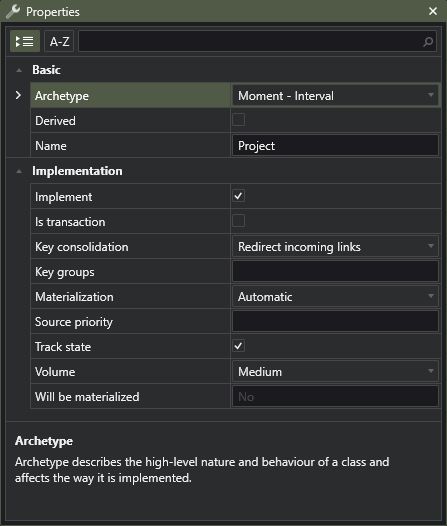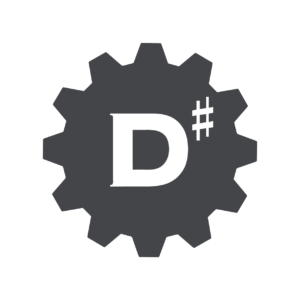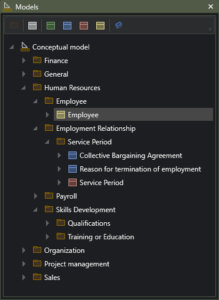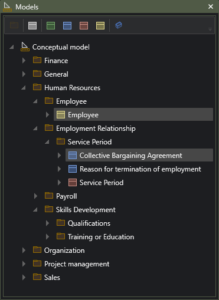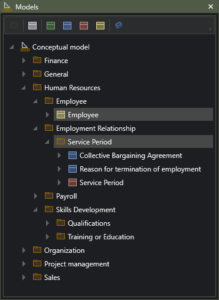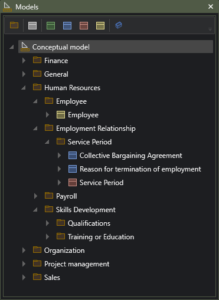DSharp Studio Modeler is a Windows application. When starting the application, you’ll need to activate a license. If there are multiple licenses available to you, please select the one that fits your purpose.
The Layout
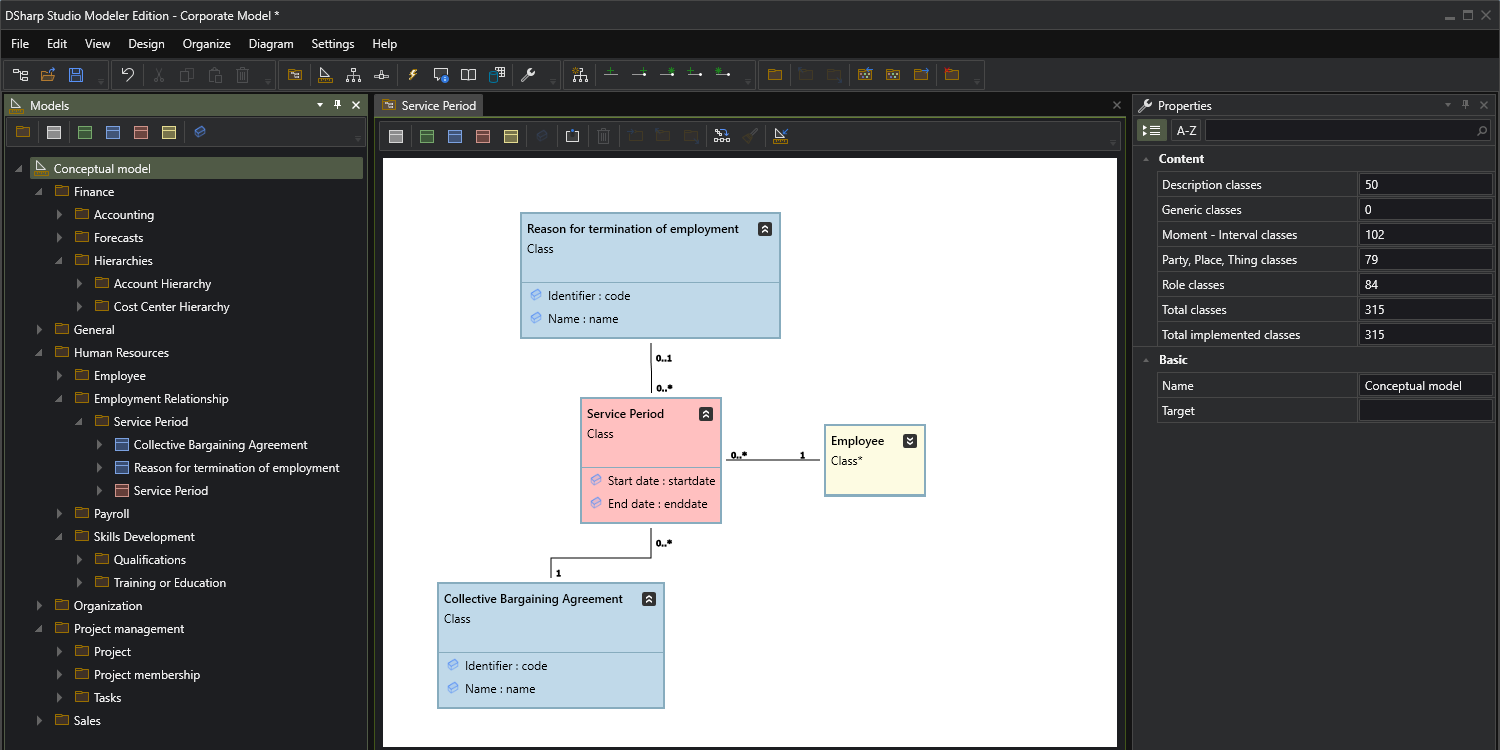
The Layout
Once you have a project going, the default application layout looks like above.
- On the left side, the Models pane displays the Conceptual model and its submodels. Also, any generated models will appear here.
- On the right side, the Properties pane is used for modifying the selected element’s details (whether it’s a model, submodel, class, attribute, association, data connection or any other type of element). Actual editability of a specific property depends on the type of property and the state of the application.
- In the center is the main working area where more user action oriented content like the Model Editor will be shown.
- At the bottom, log, console, analysis results and other informational content appears.
While this layout is a tried-and-tested layout that works well for the intended purpose and natural workflow of this application, users can move the panes as they desire, even outside the application’s defined area. With a multiple monitor setup, it might, for example, in some cases be beneficial to pull some diagrams out of the application’s main window to a secondary monitor for quick reference while working on a submodel in the working area.
Generally, it can be stated that:
- The structure of the model is maintained in the Models pane (contents can also be referred to as hierarchy or tree view).
- The content of the model is maintained in the Model Editor. Note that almost all actions can also be performed in the Models pane, but since the tree view show all levels of submodels, while the Model editor only displays one at a time, some actions can be done in the Models pane that cannot be done in the Model Editor.
- The properties of model elements are viewed and edited in the Property pane.
- In addition to these, the menus and toolbars contain a myriad of usability-enhancing and time saving functions. The application also supports special input mechanisms such as Quick Input.
Models And Submodels
In the context of DSharp Studio Modeler 5.0, models and submodels are fundamental organizational units used to structure and manage the content of the model. Here’s an overview of how models and submodels function within the application.
Models
- A model in DSharp Studio Modeler represents a comprehensive conceptual framework designed to capture various aspects of a system, process, or domain. The Conceptual model is the model that is being built when you use the application.
- There is some specific need that drives the design of the model. That need defines what is and what is not important, ie what should and should not exist in the model, and what the appropriate granularity and overall detail level is.
- The model states what is true at any given moment.
- Technically and visually, the model serves as a container, organizing related elements that collectively define the structure and behavior of the modeled domain.
Submodels
- Submodels are hierarchical subdivisions within a larger model, enabling finer-grained organization and specialization of the model content.
- They allow for the segmentation of complex models into manageable sections, facilitating clearer representation and focused analysis of specific domains or subsystems.
- Submodels may encapsulate distinct functional areas, subsystems, or layers within the overall model architecture.
The relationship between models and submodels is analogous to the relationship between a whole and its parts. Models provide overarching context and structure, while submodels offer detailed perspectives and specialized representations within that context.
By leveraging submodels effectively, users can streamline the modeling process, enhance model clarity and comprehensibility, and accommodate diverse modeling requirements across various domains and contexts.
Power User tip: Build small submodels. There is no shame in even having just one class in a submodel. That usually signifies that it is a shared class that several other classes refer to, but it does not “belong” to any of those more than the others.
Power User tip: Use the Organize commands to keep the model structure.
Understanding the Selection
All commands operate on the current UI selection made in the active pane. Some commands work with only one element selected, others may need two or more elements selected. Some commands are adaptive, meaning they behave slightly differently depending on how many elements have been selected. Some commands disregard the selection entirely.
There are three aspects of the Selection to understand in order to take full advantage of the commands:
- Selected elements: a set containing every element that the user has individually selected in the UI. The number of Selected elements can be anything from zero upwards. If it is zero, there is no selection.
- Selected element: if the number of Selected elements is 1, that element will be the Selected element. If the number of Selected elements is anything else than 1, Selected element is nothing.
- Extended selection: A set of elements that contains every element in Selected elements, but also every descendant element that is a Class or a container (Model or Submodel) for each container in Selected elements. This applies to the Conceptual model branch in the Models tree. So just click on Conceptual model, and every Class in your model is contained in the Extended selection. Unleash commands!
Some Selection Examples
- Selected elements contains the class Employee
- Selected element is the class Employee
- Extended selection contains the class Employee
- Selected elements contains the submodel Employee
- Selected element is the submodel Employee
- Extended selection contains the submodel Employee and class Employee
- Selected elements contains the classes Employee and Collective Bargaining Agreement
- Selected element is nothing
- Extended selection contains the classes Employee and Collective Bargaining Agreement
- Selected elements contains the class Employee and submodel Service Period
- Selected element is nothing
- Extended selection contains the classes Employee, Collective Bargaining Agreement, Reason for termination of employment and Service Period as well as the submodel Service Period
- Selected elements contains the submodels Finance, Sales and Service Period as well as the classes Employee and Collective Bargaining Agreement
- Selected element is nothing
- Extended selection contains the classes Employee, Collective Bargaining Agreement, Reason for termination of employment and Service Period, as well as the submodel Service Period. It also contains all the classes and submodels that exist in the Finance and Sales submodels.
Note that if Collective Bargaining Agreement were not selected, the Extended selection would still remain the same, while Collective Bargaining Agreement would be missing from Selected elements.
- Selected elements contains the model Conceptual model
- Selected element is Conceptual model
- Extended selection contains the Conceptual model as well as its every submodel and every class in the model. Everything.
Each command operates on one and only one of these Selection aspects, and you can check it for each command in the command reference.
Some adaptive commands that work with a single element in the selection will usually repeat the same operation individually for all elements in the selection. Copy will put each element onto the object clipboard, and Set Archetype to Description will do the same thing for all classes in the extended selection.
Some adaptive commands that even in their simplest case need two elements to work (like those creating an association between existing classes) will usually also work with more than two selected elements. When applying such a command on a multiple selection, the first element selected is always the common element of what is usually a sequence of pairwise operations. For example, selecting 5 classes and running a command that creates a one-to-many association will create 4 new associations between selected element number 1 and 2, 1 and 3, 1 and 4 and finally 1 and 5, respectively.
In case of adaptive commands, the name of the command always reacts to the selection and will let you know which element is the target element, making it clear what is about to happen.
Feel free to experiment by making different selections and then observe how the command changes its name to reflect the selection and the action it is going to perform.
Working With Projects
After launching DSharp Studio Modeler, you can start working by:
- Creating a new project
- Opening an existing project
- Importing a project from a third party tool
Importing a third party tool project creates a new unsaved project. If you are using the full DSharp Studio, you can directly generate the DW from the imported model, provided that you also have the necessary mapping files.
You can only have one project open in DSharp Studio at a time. However, you can run multiple instances of it, should you need to work on several projects simultaneously.
Power User tip: if you are regularly working with one particular project, you can tick the Open last project on startup option in Application Settings.
The Model Editor
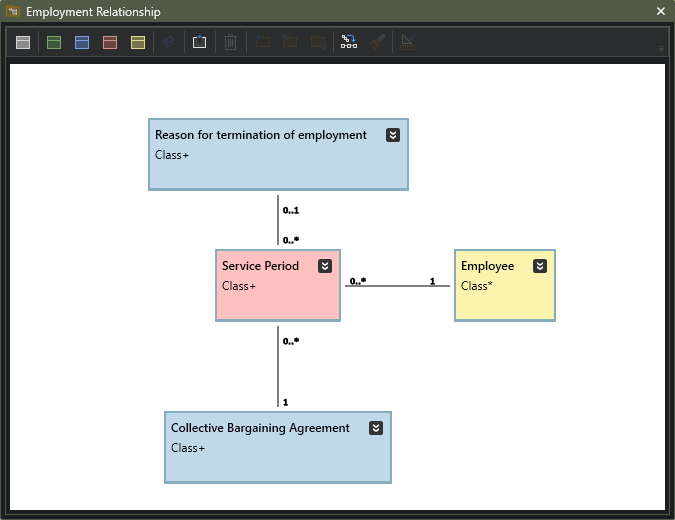
This is the heart of the application where you visually build the model.
You should not think of it as a generic diagram editor, but rather a highly focused tool. The Model Editor keeps the diagram clean by removing classes that do not belong there. Classes that do belong there are:
- classes that are direct children to the submodel
- classes that these classes depend on, ie there is an association to the class outside the submodel that defines a dependency. For example, a Project Task is dependent on its Project, and in case Project Task class were to reside in a different submodel than Project, the Model editor for Project Task would also display Project. Classes not native to the submodel are shown as semi-transparent in the Model Editor.
Power User tip: Always create new classes with one or more to-be-associated classes selected, or press p, d, m or r while drawing the association and dropping the end onto an empty spot on the canvas.
Models
This is where you build and maintain the structure of your model. Here you can create new elements, delete unnecessary ones, rearrange, copy, paste and drag and drop. The model you are constructing is the Conceptual model, so all elements you can create and delete reside in that branch of the tree.
Models that are generated will also show up in this tree.
In the pane’s toolbar you will find the most relevant commands that allow you to quickly work on the structure right here in the tree.
Power User tip: Learn the menu command keyboard shortcuts! Start with ALT + M/P/D/R/A for class and attribute creation and CTRL+ALT+H/Q for associations. Those will get you a long way quickly.
Power User tip: Use Quick Input for creating attributes (also in Model Editor).
Power User tip: You can define the business keys for several classes in one action. Just select the key elements for each class and press CTRL+K.
Diagrams
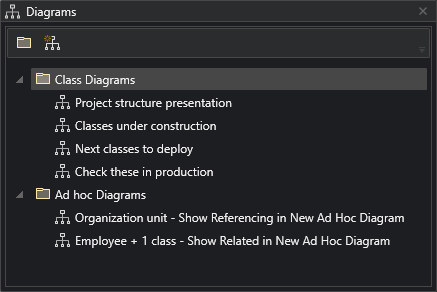
The Diagrams hierarchy contains custom Diagrams. Any diagrams that are under the Class Diagrams folder will be saved as part of the project, diagrams under Ad Hoc Diagrams will not.
Class Diagrams are usually constructed for some specific recurring need, while Ad Hoc diagrams are more like visual queries in nature and are created for the moment.
Power User tip: In addition to presentations, you can use Class Diagrams as a “Favorites Folder”, adding the classes you are currently working on to one diagram, if they happen not to live in the same submodel. From the diagram you can then easily apply relevant commands to all classes in one go, such as generating SQL queries or building deployment packages.
Diagram
A Diagram is a free-form canvas for displaying classes and their relationships. Compared to the Model Editor, the diagram serves a different purpose: here you can freely choose which classes and associations you include in the diagram. Diagrams can be created for several different purposes, both for recurring needs and for needs you have in the moment.
You can also view a Diagram as a visual query tool that lets you browse the structure of the model. The Diagram contains functions that let you discover how classes relate to each other by visualising both incoming and outgoing references, either just to/from their closest neighbours, or recursively showing several steps of references..
The Diagram has a very different command set from Model Editor. A Diagram is not for modeling, it is for presenting, displaying and exploring.
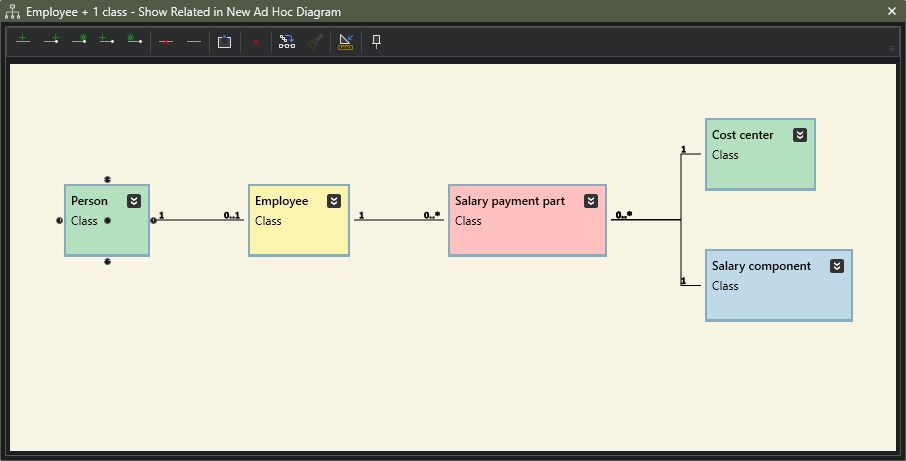
Connections
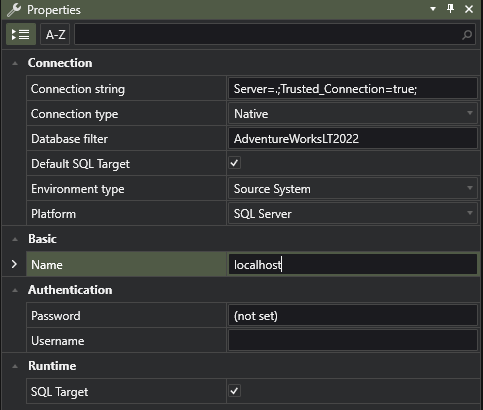
In Connections, you can create database connections for various purposes. Typically would need to browse data (source data, DW content etc) or just have a look at the structure of the data. You can also import tables into your Conceptual model as new classes.
You can use a Connection that points to actual source data to import the table structure into DSharp Studio Modeler as classes. You can do this by dragging the desired tables from the Connections view and dropping them onto a folder or a class in the Conceptual model or Diagram.
- For each table a new class will be created.
- For each table column that is not a foreign key reference, an attribute is created in the new class (or in the class the columns were dropped on).
- For each table column that is a foreign key reference, an association is created from the new class / drop target class to the class represented by the table referenced by the foreign key, if that table is not missing from the current dragged selection. If it is, the column will be created as an attribute.
Creating a new connection defaults to a local SQL Server connection.
Quick Input
The Quick Input feature is another huge time saver that allows for one-click creation of several submodels, classes, attributes, and associations. In practice, you just need to write the desired elements into the designated text area, each on its own line. The code will then be applied to the Selected elements.
s Submodel
m/p/d/r/g New Moment – Interval / Party, Place, Thing / Description / Role / Generic Class
Attribute:Datatype
Class
Role:Class
The text in the image will yield the following content:

Since you still will need to write class and attribute names, this is the quickest possible way to create new content into your model.
Power User tip: In order to only have to write repeating elements once, make clever multiple selections to apply your Quick Input code to.
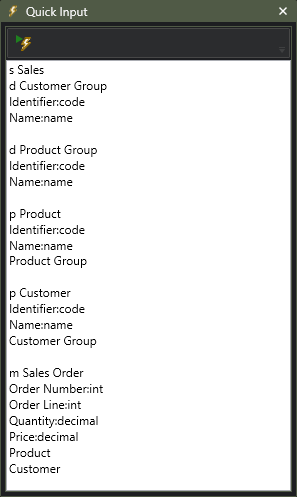
Description

Select any element within Conceptual model or Connections and write a text describing it. The description should serve the purpose of enhancing the understandability of the model as a whole, and it should be derived from the model’s intended purpose.
For classes, the Description shows same content that is shown in the Glossary.
Power User tip: att the very least, document all classes (do that in Glossary), and also any attributes that are not immediately obvious to everybody in the workshop. Also, for any association or association end that has an optional cardinality (0..1, sometimes even 0..*), write down the cases for when there is and when there isn’t anything to be found at that end of the association.
Glossary
The Glossary is a listing of all Classes in the Conceptual Model. It is an excellent tool for quickly writing descriptions for all classes, one submodel at a time.
The Glossary provides extensive grouping and filtering functions.
Power User tip: spend the time needed writing down the definitions of the classes.
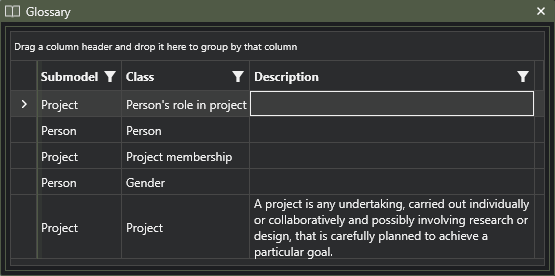
Data Grid
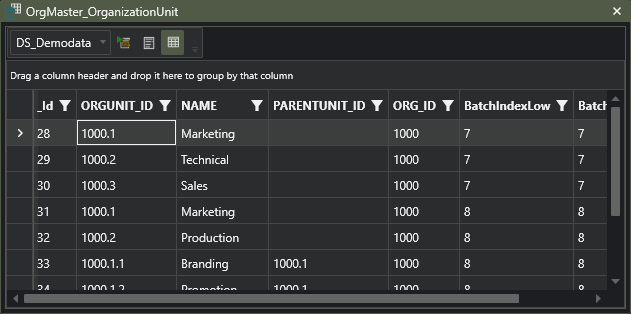
The Data Grid is used for browsing data. Data can be browsed for any connection defined in Connections, depending on credentials.
You can write custom SQL in the Data Grid, or, depending on your license, just click on classes or tables anywhere in the UI to display the data behind the clicked element.
Perfect for inspecting both source data and DW content.
Properties
The Properties pane (or the Property Grid) is used for editing individual properties of all editable elements in the models.
Only in very few cases will the Property Grid validate and open a message box reporting an error in the property values being provided by the user. The design decision here is that it should be a quick input mechanism and not interrupt the flow. Properties affecting any implementation will be analysed in the full DSharp Studio prior to generating the implementation, so any mistakes made in the Property Grid will be caught and can be corrected at a later time.
Every element type has unique set of properties. The relevant properties are documented here.
